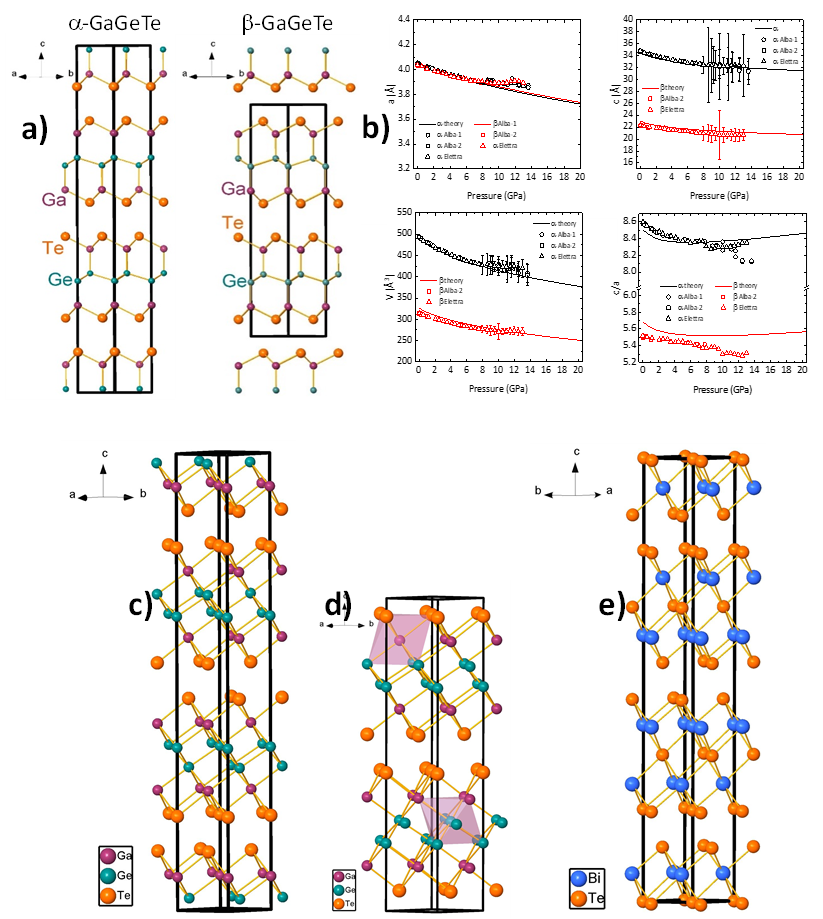Do you want to keep up to date? Subscribe to our newsletter. 1 mail every 2 months! |
 |

Cerdanyola del Vallès (Barcelona), 15th September 2023. Topological semimetals are materials that have attracted the interest of the scientific community due to its unusual electronic properties, with huge potential in the development of countless devices and applications, like optical detectors, spintronics or more efficient thermoelectrics.
Gallium Germanium Telluride (GaGeTe) is a layered compound chemically stable in air and water at room conditions. It is made of a corrugated layer of germanene embedded between the two sublayers of GaTe, enabling a high electrical carrier mobility that can be very useful in the development of 2D nanoelectronic and optoelectronic applications.
Recently, it has been proved that this compound exists in two different crystalline structures (polytypes), meaning that both have the same atoms but stacked in a different way.
Now, researchers from the Universitat Politècnica de València, Universitat de València, Universidad de La Laguna, University of Porto, University of El Salvador, University of Pardubice and ALBA and Elettra synchrotrons, have undergone a comprehensive experimental and theoretical analysis to describe the structural, vibrational and electronic properties of both structures under high pressure They have found two phase transitions (7 and 15 GPa approximately) in the range up to 18GPa and the loss of the topological features above 3 GPa.
These transitions indicate a change from the tetrahedral coordination of Ga and Ge atoms at low pressure towards the octahedral coordination in the high-pressure phases. The proposed intermediate structures (alpha' and beta') above 7 GPa are unique since they have not been observed in any other compound, although it bears a resemblance to the tetradymite structure of Bi2Te3. On the other hand, the phase above 15 GPa exhibits considerable symmetry, suggesting a derivation from the rocksalt structure typical of parent III-VI compounds at high pressure.
The research team has used high-pressure Raman scattering and X-ray diffraction measurements performed at the MSPD beamline of the ALBA Synchrotron and XPRESS beamline of Elettra (Italy), along with theoretical calculations at different pressures. In particular, studies with synchrotron light have been key to distinguish the two different crystalline structures of GAGeTe and show that they have similar behaviors under high pressure although they belong to different space groups.
This work has been done by members of the MALTA Consolider project, that gathers more than 70 researchers and 12 research groups from different countries, to carry out high-pressure studies about water and life-related systems, physical properties and chemical reactivity of molecular systems and structure, stability and reactivity of minerals.

Figure: (a) Schematic illustration of the two polytypes of GaGeTe; (b) Pressure dependence of the unit-cell volume and lattice parameters of the low-pressure phase of both polytypes. Black and red symbols correspond to the α and β polytype, respectively; 3D view of the hexagonal unit cell of (c) α’-GaGeTe, (d) β’-GaGeTe, and (e), and Bi2Te3 (c).
Acknowledgements: This work is part of the project MALTA Consolider Team Network (RED2022-134388-T), financed by MINECO/AEI/10.13039/501100003329; by I+D+i projects PID2019-106383GB-41/42/43, FIS2017-83295-P and PID2021-125927NB-C2 financed by MCIN/AEI/10.13039/501100011033; and by project PROMETEO CIPROM/2021/075 (GREENMAT), financed by Generalitat Valenciana. This study forms part of the Advanced Materials program and is supported by MCIN with funding from European Union NextGeneration EU (PRTR-C17.I1) and by Generalitat Valenciana through projects MFA/2022/007 and MFA/2022/025 (ARCANGEL). Authors thank the ALBA Synchrotron for the XRD experiments performed at the MSPD beamline with the collaboration of ALBA staff (proposals No. 2015021222 and 2020074395) as well as the Elettra Sincrotrone Trieste for XRD experiments performed at the XPRESS beamline (proposal 20215005, in-house experiment).




